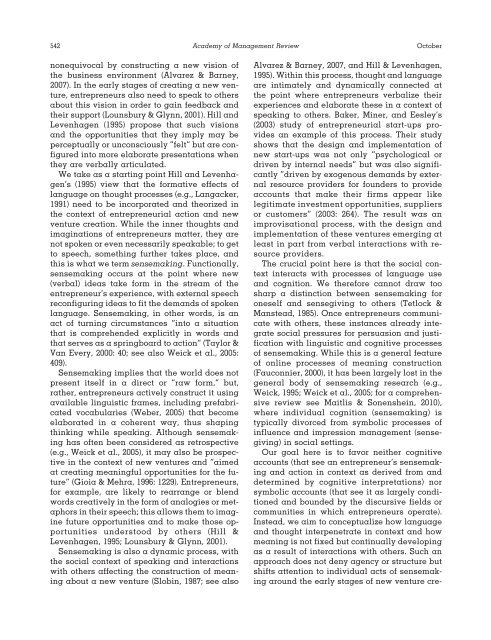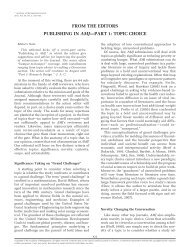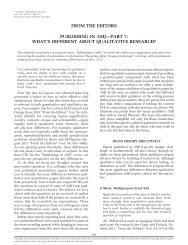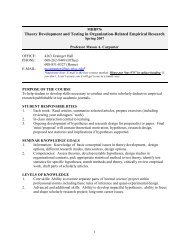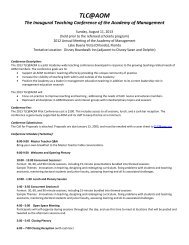inductive reasoning and the creation and justification of new ventures
inductive reasoning and the creation and justification of new ventures
inductive reasoning and the creation and justification of new ventures
You also want an ePaper? Increase the reach of your titles
YUMPU automatically turns print PDFs into web optimized ePapers that Google loves.
542 Academy <strong>of</strong> Management Review<br />
October<br />
nonequivocal by constructing a <strong>new</strong> vision <strong>of</strong><br />
<strong>the</strong> business environment (Alvarez & Barney,<br />
2007). In <strong>the</strong> early stages <strong>of</strong> creating a <strong>new</strong> venture,<br />
entrepreneurs also need to speak to o<strong>the</strong>rs<br />
about this vision in order to gain feedback <strong>and</strong><br />
<strong>the</strong>ir support (Lounsbury & Glynn, 2001). Hill <strong>and</strong><br />
Levenhagen (1995) propose that such visions<br />
<strong>and</strong> <strong>the</strong> opportunities that <strong>the</strong>y imply may be<br />
perceptually or unconsciously “felt” but are configured<br />
into more elaborate presentations when<br />
<strong>the</strong>y are verbally articulated.<br />
We take as a starting point Hill <strong>and</strong> Levenhagen’s<br />
(1995) view that <strong>the</strong> formative effects <strong>of</strong><br />
language on thought processes (e.g., Langacker,<br />
1991) need to be incorporated <strong>and</strong> <strong>the</strong>orized in<br />
<strong>the</strong> context <strong>of</strong> entrepreneurial action <strong>and</strong> <strong>new</strong><br />
venture <strong>creation</strong>. While <strong>the</strong> inner thoughts <strong>and</strong><br />
imaginations <strong>of</strong> entrepreneurs matter, <strong>the</strong>y are<br />
not spoken or even necessarily speakable; to get<br />
to speech, something fur<strong>the</strong>r takes place, <strong>and</strong><br />
this is what we term sensemaking. Functionally,<br />
sensemaking occurs at <strong>the</strong> point where <strong>new</strong><br />
(verbal) ideas take form in <strong>the</strong> stream <strong>of</strong> <strong>the</strong><br />
entrepreneur’s experience, with external speech<br />
reconfiguring ideas to fit <strong>the</strong> dem<strong>and</strong>s <strong>of</strong> spoken<br />
language. Sensemaking, in o<strong>the</strong>r words, is an<br />
act <strong>of</strong> turning circumstances “into a situation<br />
that is comprehended explicitly in words <strong>and</strong><br />
that serves as a springboard to action” (Taylor &<br />
Van Every, 2000: 40; see also Weick et al., 2005:<br />
409).<br />
Sensemaking implies that <strong>the</strong> world does not<br />
present itself in a direct or “raw form,” but,<br />
ra<strong>the</strong>r, entrepreneurs actively construct it using<br />
available linguistic frames, including prefabricated<br />
vocabularies (Weber, 2005) that become<br />
elaborated in a coherent way, thus shaping<br />
thinking while speaking. Although sensemaking<br />
has <strong>of</strong>ten been considered as retrospective<br />
(e.g., Weick et al., 2005), it may also be prospective<br />
in <strong>the</strong> context <strong>of</strong> <strong>new</strong> <strong>ventures</strong> <strong>and</strong> “aimed<br />
at creating meaningful opportunities for <strong>the</strong> future”<br />
(Gioia & Mehra, 1996: 1229). Entrepreneurs,<br />
for example, are likely to rearrange or blend<br />
words creatively in <strong>the</strong> form <strong>of</strong> analogies or metaphors<br />
in <strong>the</strong>ir speech; this allows <strong>the</strong>m to imagine<br />
future opportunities <strong>and</strong> to make those opportunities<br />
understood by o<strong>the</strong>rs (Hill &<br />
Levenhagen, 1995; Lounsbury & Glynn, 2001).<br />
Sensemaking is also a dynamic process, with<br />
<strong>the</strong> social context <strong>of</strong> speaking <strong>and</strong> interactions<br />
with o<strong>the</strong>rs affecting <strong>the</strong> construction <strong>of</strong> meaning<br />
about a <strong>new</strong> venture (Slobin, 1987; see also<br />
Alvarez & Barney, 2007, <strong>and</strong> Hill & Levenhagen,<br />
1995). Within this process, thought <strong>and</strong> language<br />
are intimately <strong>and</strong> dynamically connected at<br />
<strong>the</strong> point where entrepreneurs verbalize <strong>the</strong>ir<br />
experiences <strong>and</strong> elaborate <strong>the</strong>se in a context <strong>of</strong><br />
speaking to o<strong>the</strong>rs. Baker, Miner, <strong>and</strong> Eesley’s<br />
(2003) study <strong>of</strong> entrepreneurial start-ups provides<br />
an example <strong>of</strong> this process. Their study<br />
shows that <strong>the</strong> design <strong>and</strong> implementation <strong>of</strong><br />
<strong>new</strong> start-ups was not only “psychological or<br />
driven by internal needs” but was also significantly<br />
“driven by exogenous dem<strong>and</strong>s by external<br />
resource providers for founders to provide<br />
accounts that make <strong>the</strong>ir firms appear like<br />
legitimate investment opportunities, suppliers<br />
or customers” (2003: 264). The result was an<br />
improvisational process, with <strong>the</strong> design <strong>and</strong><br />
implementation <strong>of</strong> <strong>the</strong>se <strong>ventures</strong> emerging at<br />
least in part from verbal interactions with resource<br />
providers.<br />
The crucial point here is that <strong>the</strong> social context<br />
interacts with processes <strong>of</strong> language use<br />
<strong>and</strong> cognition. We <strong>the</strong>refore cannot draw too<br />
sharp a distinction between sensemaking for<br />
oneself <strong>and</strong> sensegiving to o<strong>the</strong>rs (Tetlock &<br />
Manstead, 1985). Once entrepreneurs communicate<br />
with o<strong>the</strong>rs, <strong>the</strong>se instances already integrate<br />
social pressures for persuasion <strong>and</strong> <strong>justification</strong><br />
with linguistic <strong>and</strong> cognitive processes<br />
<strong>of</strong> sensemaking. While this is a general feature<br />
<strong>of</strong> online processes <strong>of</strong> meaning construction<br />
(Fauconnier, 2000), it has been largely lost in <strong>the</strong><br />
general body <strong>of</strong> sensemaking research (e.g.,<br />
Weick, 1995; Weick et al., 2005; for a comprehensive<br />
review see Maitlis & Sonenshein, 2010),<br />
where individual cognition (sensemaking) is<br />
typically divorced from symbolic processes <strong>of</strong><br />
influence <strong>and</strong> impression management (sensegiving)<br />
in social settings.<br />
Our goal here is to favor nei<strong>the</strong>r cognitive<br />
accounts (that see an entrepreneur’s sensemaking<br />
<strong>and</strong> action in context as derived from <strong>and</strong><br />
determined by cognitive interpretations) nor<br />
symbolic accounts (that see it as largely conditioned<br />
<strong>and</strong> bounded by <strong>the</strong> discursive fields or<br />
communities in which entrepreneurs operate).<br />
Instead, we aim to conceptualize how language<br />
<strong>and</strong> thought interpenetrate in context <strong>and</strong> how<br />
meaning is not fixed but continually developing<br />
as a result <strong>of</strong> interactions with o<strong>the</strong>rs. Such an<br />
approach does not deny agency or structure but<br />
shifts attention to individual acts <strong>of</strong> sensemaking<br />
around <strong>the</strong> early stages <strong>of</strong> <strong>new</strong> venture cre-


